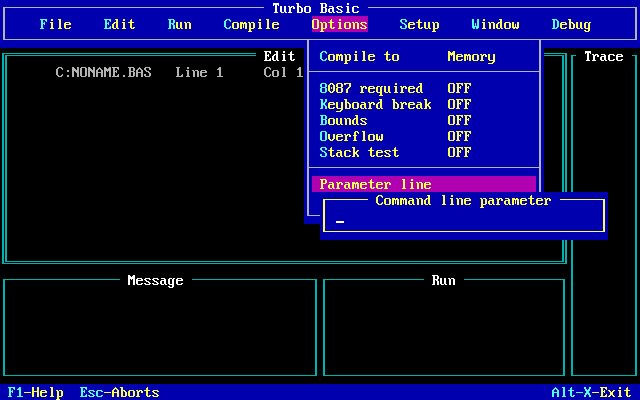
Borland Turbo Basic Compiler
Auslogics BoostSpeed 9 Key + Serial Key and License Key Full Version Free Download. Auslogics BoostSpeed 9 Serial Key. Auslogics BoostSpeed 9 Key 2016 is the world’s most popular software to boost the speed of slow working PC, Mac, and Laptop. It includes all those tools that you need to enhance the speed of any operating system especially Windows 10. Auslogics boost speed 9 License Key. Auslogics boost speed 9 key Serial best way to maximise your PC’s operating efficiency. Especially designed to improve the operating system of your PC by optimising the weakling in an operating system. With this software, you can easily manage everything about your system. Serial key of auslogics boost speed 9 working capital calculation. Auslogic Boost Speed » Auslogic Boost Speed activation key and crack serial number.
Turbo C is an Integrated Development Environment and compiler for the C programming language from Borland. First introduced in 1987, it was noted for its integrated development environment, small size, fast compile speed, comprehensive manuals and low price.

Contents • • • • • • • • • • • • • • • • • • • • • • • • • History [ ] The first version of the DOS compiler was published as BASIC/Z, the very first interactive compiler for CP/M and MDOS. Later it was extended to MS-DOS/PC DOS and in 1987 distributed it as Turbo Basic. Turbo Basic was originally created by Robert 'Bob' Zale (1945–2012) and bought from him. When Borland decided to stop publishing it (1989), Zale bought it back from them, renamed it to PowerBASIC and set up PowerBASIC Inc. To continue support and development of it; it was later called PBDOS. PowerBASIC went on to develop Basic compilers for Windows, first PBWIN — their flagship product — then PBCC, described below. On November 6, 2012, Robert Zale, the creator of PowerBASIC, died.
For a time, it was assumed that the company might cease operations. His wife, Mrs. Vivian Zale, posted on 8 March 2014 to the PowerBASIC forums a statement that the company would continue in operation. On May 10, 2015, Mrs. Zale announced that work was continuing on new versions of PowerBASIC compilers. On November 2, 2016, Vivian Zale announced her intention to begin seeking a buyer for the company.
The active development of the next generation of PowerBASIC products is now stopped and they no longer expect to release PBWin11/PBCC7, which were already in beta testing when Bob Zale died, nor the 64-bit compilers or PB/Pro (PBWin and CC in one compiler) which were still in the alpha stages. On January 31, 2017, Adam Drake announced Drake Software had acquired the PowerBasic source code from PowerBasic, Inc., with the intention of updating and improving the functionality of the product. This was later confirmed by Vivian Zale with a forum post thanking the members for their support.
Compilers [ ] PowerBASIC programs are self-contained and use no runtime file to execute. In all versions of the compiler the applications compile without external libraries, though you can use such libraries if desired. PBDOS creates 16-bit files, while PBWIN and PBCC create 32-bit (PE) files. Turbo Basic [ ] Borland's Turbo Basic contains extensions to classical Basic (while not breaking compatibility). One of those was a drawing API, and mouse access. Unlike most BASIC implementations of this period, Turbo Basic was a full compiler which generated native code for MS-DOS. Other implementations were either interpreters, or relied heavily on a runtime library.
The integrated development environment could run a BASIC program internally for traditional BASIC debugging (see sample below), or generate an MS-DOS stand-alone that could be run on other systems without the Turbo Basic product or runtime libraries. Code example [ ] The following program is an example of the -like BASIC dialect that Turbo Basic supported. Unlike traditional BASIC [ ], which used line numbers and had limited control structures and no support for ALGOL-like subroutines, modern BASIC dialects starting at this period were extended to make the language compatible with modern theory by discarding the line numbers and adding the control structures and subroutine definitions needed by structured programming. INPUT 'What is your name?: ', n$ PRINT 'Hello '; n$ DO s$ = ' INPUT 'How many stars do you want to print'; s FOR i = 1 TO s s$ = s$ + '*' NEXT i PRINT s$ DO INPUT 'Do you want to print more stars'; q$ LOOP WHILE LEN ( q$ ) = 0 q$ = LCASE$ ( LEFT$ ( q$, 1 )) LOOP WHILE q$ = 'y' PRINT 'Goodbye '; n$ Note that s$ is a and s is a (number). Metal gear solid 4 3d models for free roam. They are separate variables.